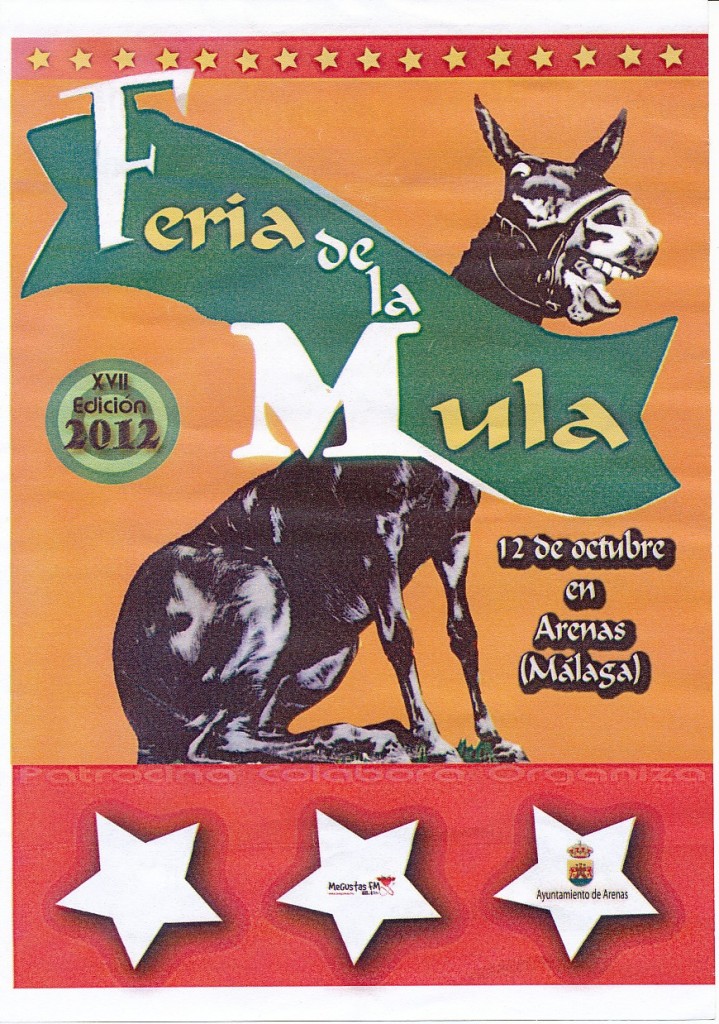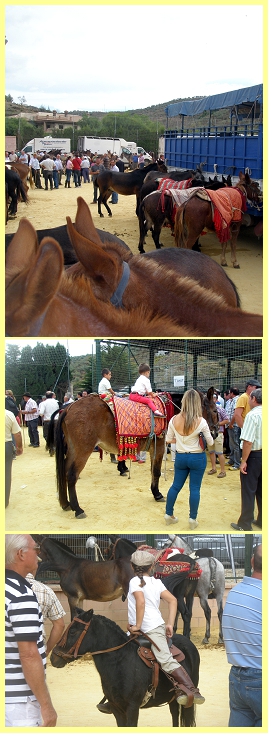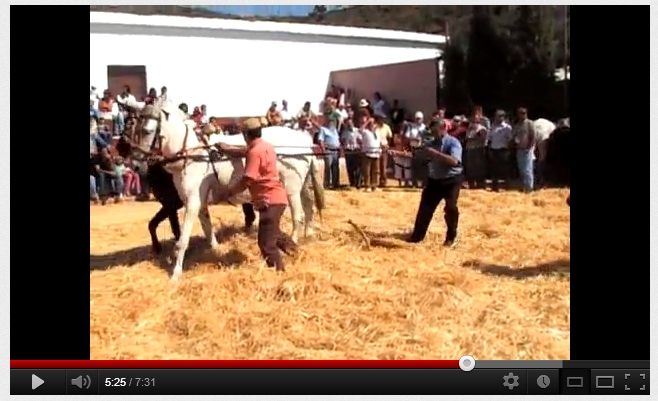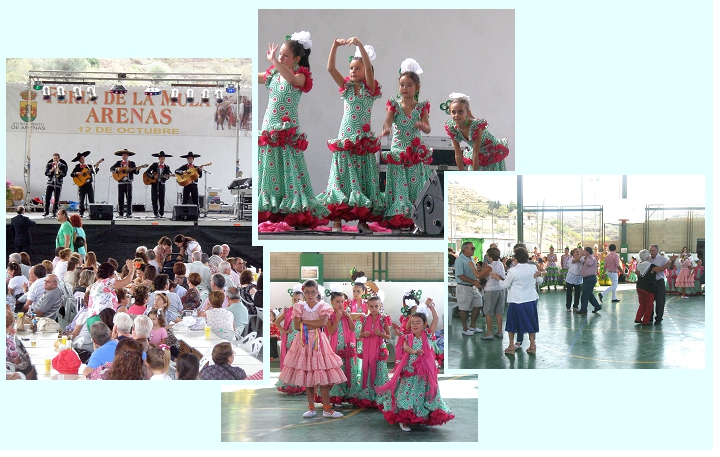
Yesterday was a bank holiday in Spain. Hispanic, or Columbus Day. This is the day that the Spanish commemorate the first landing of Columbus in the Americas in 1492. The King ceremoniously hoists a Spanish flag in the centre of Madrid, and there are various displays by the armed forces.
In our corner of Andalucia, in the little village of Arenas, population just over 1000, they do things a little differently. October 12th in Arenas is the day of the Feria de la Mula – The Festival of the Mule .
Ever since we moved here, I have wanted to get along to La Feria de la Mula, but this year was the first time we actually managed to do so.
We had heard that the Feria ran from 10am to 6pm, so reckoning on Spanish time, we set off in a leisurely fashion at about 11:45, arriving at Arenas just after midday. It is a beautiful drive around the mountain roads, stunning new views opening up around each bend in the road, and La Moroma towering above. On a clear day, range upon range of peaks can be seen, graduating from green to purple to grey in the far distance. Tiny ramshackle cortijos squat among the terraces of grapes and almond trees, and the sun glints off the minerals in the rock faces that rise above the road.
The road runs past Daimalos, a quaint little village with a population of around fifty, and then into Arenas. Normally, there is very little traffic in Arenas, but we could see cars and animal transporters parked all along both sides of the road as we approached the village. We waited while a truck negotiated a hairpin bend in front of us. In the back, a crowd of muley faces stared back at us, as we watched the precarious, but skilful manoeuvring of the driver. He had clearly done this before, and they did not seem the slightest bit concerned.
We parked the car in the first available place. As soon as we were out of it, we could hear the loud flamenco pop so popular at all the local events. It was not difficult to find our way to the centre of the activities: we just followed the general drift of people, vehicles and mules heading toward the noise. It was a beautiful day with a few white clouds in the clear blue sky. It was pleasantly warm with a slight breeze. Ideal weather for a feria.
All along the side of the steep road were horse-boxes and cars in various states of decrepitude. Suddenly, as we turned a corner, we came upon a stall, covered with brightly coloured horse accessories. Not being equestrians ourselves, we did not recognise all of them, but the red and yellow straps and embroidered saddle pads, leather harnesses covered in brass bells and other sundry objects were cheerful and welcoming.
Another stall offered a huge selection of hats. Most of them were variations on a Stetson or a flat cap, but I also spotted what looked like a cross between a deer-stalker and a Biggles hat . It had both earflaps and goggles, and rather took my fancy.
A third stall had a fine collection of horse-related metal objects, along with some saddles and a selection of pitchforks fashioned from branches. I would have loved a pitchfork, but could not really justify buying one, as I do not grow very much hay on the roof terrace.
A gateway between the stalls led into an enclosed area, the Recinta Ferial. Many of the villages have these spaces. They seem to double up as the local football ground, or the school playground quite often, or to house the market on market day. This one is roughly circular, and was covered in sand, presumably just for the day. A loud murmuring, like the sound of a very large bee hive, and the not unpleasant smell of fresh manure grew stronger as we walked through the gateway.
We were greeted by a cheerfully chaotic scene of people milling about, numerous animal transporters, rows of livestock tied to the railings or the sides of vehicles, mules in their best regalia being ridden around by their proud owners, and tiny ponies ridden by small children. Elderly ladies sat on the concrete steps that formed the seating along one side of the space. Among the various family groups strolling around, greeting each other, were small girls, gorgeous in flouncy flamenco dresses, and little boys in high-waisted black trousers, white shirts and dark coloured boaters. Groups of older men, wearing the unofficial uniform of dark trousers, striped shirts and flat caps, discussed the merits of the animals and occasionally whacked a few of them on the rump with their walking sticks. There was no obvious reason for this, but we decided that they probably do it because they can.
To our right, a mule was refusing to walk down the ramp out of a transporter. Two or three men were pushing it and shouting at it as the crowd cheered them on. A young man passed close behind me with a foal not much larger than a great dane. There were mules everywhere. A small caramel-coloured dog with short legs, big ears and swollen teats trotted happily among the legs of the mules, completely unfazed by the huge animals. A whole row of glossy rumps caught my eye, just as one of them lifted its tail and proceeded to dump a pile of steaming manure.
We decided to see what else there was to see. The road that runs down the side of the recinta had stalls selling dried fruit and nuts, toys and accessories. It led to what seemed to be the infant school playground, transformed for the occasion into a mini market. A couple of ladies had a stall full of cheese, there were tie-died babygros, jewellery, nuts, toffee apples, cakes, henna tattoos, plastic toys, churros and chocolate and a single fairground ride. In the centre was a cobbled patch, a bit like an era, the traditional threshing circle, which reminded me that I had been hoping to catch a demonstration of the trilla.
Imagine waterski-ing, on a board with wooden hobnails, being pulled around in a circle on a bed of straw by a pair of mules. That is how they thresh wheat around here. Why anyone would want to watch a bull fight, when they could watch something skilful, productive and fun like threshing is beyond me. I was disappointed that there was no demonstration this year, but many things have been hit by the financial crisis, and local ferias are a little scaled down compared to previous years.
As we were browsing around, an announcement in rapid, distorted Spanish boomed out. Because the Spanish are a naturally noisy people – half the speed, double the volume, as we were told when we first came here – the public address systems are always turned up very high, and the quality of the sound is not always marvellous. It’s part of the fun, and you get used to it.
We made our way into the sports ground below the recinta, where trestle tables with seating for hundreds of people had been laid out in front of a large stage. A girl in a little black number was belting out flamenco pop, accompanied by a couple of men in black shirts and trousers, who were definitely nowhere near as attractive as she was. They concentrated on backing music and vocals, as she swayed and stamped and wiggled her hips, flailing her very best flamenco arms to enhance her performance. A gaggle of small girls in frilly flamenco dresses practised their moves in a corner close to the stage, and a few couples paso dobled cheerfully in the space in front.
The standard practice at village ferias is to have a few street bars set up, where you can buy drinks or snacks. We ambled over to the bar to see what was on offer. As usual, a ticket system was in operation: you buy tickets at one end of the bar, and exchange them for drinks or food. As we were buying our tickets, I noticed that a lady standing near us had a couple of flyers for the feria. I wondered where she had found them, and decided to keep my eyes open. Some sort of a programme of events would be useful, but they are not always available, so the mystified visitor goes with the flow, and often misses the main event, which has probably only been mentioned in a garbled and distorted announcement over the P.A. It is very easy to think that everything has finished, when the interval between events is long by British standards.
Drinks in hand, we noticed that the various children and young women in flamenco regalia were coalescing into several groups close to the stage. Even the tiny ones had their hair dressed with elaborate combs and flowers, and the groups of them in their pinks, oranges, purples, greens and yellows were vaguely reminiscent of old-fashioned municipal flowerbeds.
The first group of tiny girls took the stage. I guessed them to be between four and six years old. Even at this young age, they have learned to flip their brightly coloured frothy petticoats about, and to stretch their bodies into elegant lines, their arms extended as they turn their hands and wrists in that distinctive graceful flourish.
Their cheeky little dance with choreographed bunny hops and cute bottom wiggling was a delight to watch. There is something universal about groups of small girls performing. There always seems to be one who is particularly cheeky, who grins her way through everything, while a little dumpy one at the end concentrates intensely and maintains a steady pace, one beat behind the others. There is one bossy boots, who pushes the others into place, and one who shows even at this early point in her career that she has natural grace and ability.
The seating at the trestle tables was filling up, and those who had seats were bagging seats for friends and family, so there were numerous empty chairs, but nowhere for us to sit. Fortunately, there were various bits of wall to loll against, so we moved from place to place, taking photographs from different vantage points as the performance progressed.
Each of the age groups danced in turn, finishing with the young women, whose costumes were slightly more cut away, showing off their midriffs. I was beginning to covet the flyers the lady in turquoise had. There did not appear to be any piles of them anywhere about, and she was gradually screwing the ones she had into a crumpled mess. She clearly did not appreciate them as she should. I decided that if I could not find one of my own, I would ask if I could take a look at hers, and try to take a photograph before they were too badly mangled. I have a bit of a penchant for Spanish posters, which vary hugely in style and quality, and I had a feeling this one was going to be good!
As the last group finished their dance, we moved back toward the bar, and while Geoff was exchanging vouchers for drinks, I made the acquaintance of a labrador puppy. The lady with the flyers was standing nearby, chatting with a small group of people. As they moved off, I sidled over and asked where she had found the flyers. She seemed surprised that I was interested, but thrust one into my puppy-punctured hand. I wondered if she was supposed to be handing them out, and was relieved to have got rid of another one.
It turned out that it was a programme for the day. Scanning the reverse of the sheet, I saw, to my delight, that there was soon going to be a performance by Los Mariachis Costa del Sol. We knew we would not be able to stay for the paella and exquisita porción de tarta, but consulting the programme, we could see that we had caught most of the action.
Another turn around the recinta, admiring the mules, snapping a few more pictures, and a trip to find the loos kept us occupied until an announcement warned us the Mariachis were about to perform. They were brilliant. Admittedly, I am a total sucker for mariachis anyway, but they were very, very good.
It was a five-piece line-up, with three guitars, one acoustic bass guitar almost as big as the man playing it, and a trumpet. They all wore huge, decorated sombreros, red ties and black suits, adorned with elaborate embroidery on the jackets and down the sides of the trousers.
Unlike the harsh but fascinating flamenco style of singing, the mariachis harmonise tunefully, and sing songs with rhythms that are comfortable to ears that have been brought up on western music. The crowd joined in with a spirited rendition of Volver, volver and the dance floor filled up with couples.
One of the things I love about ferias is that all age groups will dance together, grandsons will dance with their grandmothers, ladies dance with their friends, teenagers in impossible stilettos and tiny skirts strut their stuff, and children bop about merrily. The dancing is expressive and sensuous, but there is rarely anything overtly sexual or suggestive. As far as I can tell, nobody is self-conscious: they just enjoy themselves responding to the music and sharing the fun.
After a few numbers, the mariachis made way for the Alcaldesa, a stately lady in a tight-fitting shiny maroon costume. She was admirably concise. At some events, the dignitaries hold forth at great length, and are largely unintelligible to me. Not so la Alcaldesa: she welcomed everyone to this seventeenth Feria de la Mula, and explained that mules are an important part of the life of the area, as they plough the steep hillsides, carry loads and bring back the harvests of grapes, olives and almonds. She praised the standard of the livestock at the Feria, and mentioned improved standards of husbandry and animal welfare. She took the opportunity to express her concern that the financial crisis was affecting everyone in the rural communities, and urged us all to support and help each other. She promised that the Ayuntamiento would do all in its power to maintain the traditions and festivals while times were hard, and exhorted everyone to enjoy the rest of the day.
The mariachis returned and the singing and dancing continued. The trumpet sang out above the noise of the crowd, crooning, wailing, and at one point doing a very good impression of a horse neighing. The small gentleman on the bass guitar looked as if he could barely reach around its fat body to pluck the strings.
The smell of the paella cooking mingled with the cigarette smoke, beer fumes and manure. Small children with Spongbob Squarepants helium balloons weaved their way between the groups of adults. An elderly couple sat on a bench with their arms around each other. We decided, with regret, that we needed to be making our way home.
As we walked down the hill to the car, we could hear the strains of Cherry Pink, apple blossom white swooping and soaring above the village and around the mountainsides. It had been a good day, and a trip well worth making.












How interesting and sounded like fun– will certainly put it in mind for another year –thanks for sharing x